Taxation Theory, Practice & Law Report: Capital Gain and FBT Analysis
VerifiedAdded on 2020/12/09
|20
|3032
|421
Report
AI Summary
This report provides a detailed analysis of taxation principles, focusing on capital gains tax (CGT) and fringe benefit tax (FBT) within the Australian context. The report addresses specific scenarios involving a client's assets, including a house, antique bed, painting, shares, and a violin, to determine the net capital gain as of June 30, 2018. It also advises on fringe benefit tax implications for assets like a car and a loan, examining different methods for calculating FBT, such as the statutory and cost methods, and analyzing the tax consequences based on how a loan amount is used, including purchasing a holiday house and securities. The report offers legal references and suggestions, adhering to the regulations set by the Federal Registrar of Legislation and the Australian Taxation Office.

TAXATION THEORY, PRACTICE
& LAW
& LAW
Paraphrase This Document
Need a fresh take? Get an instant paraphrase of this document with our AI Paraphraser
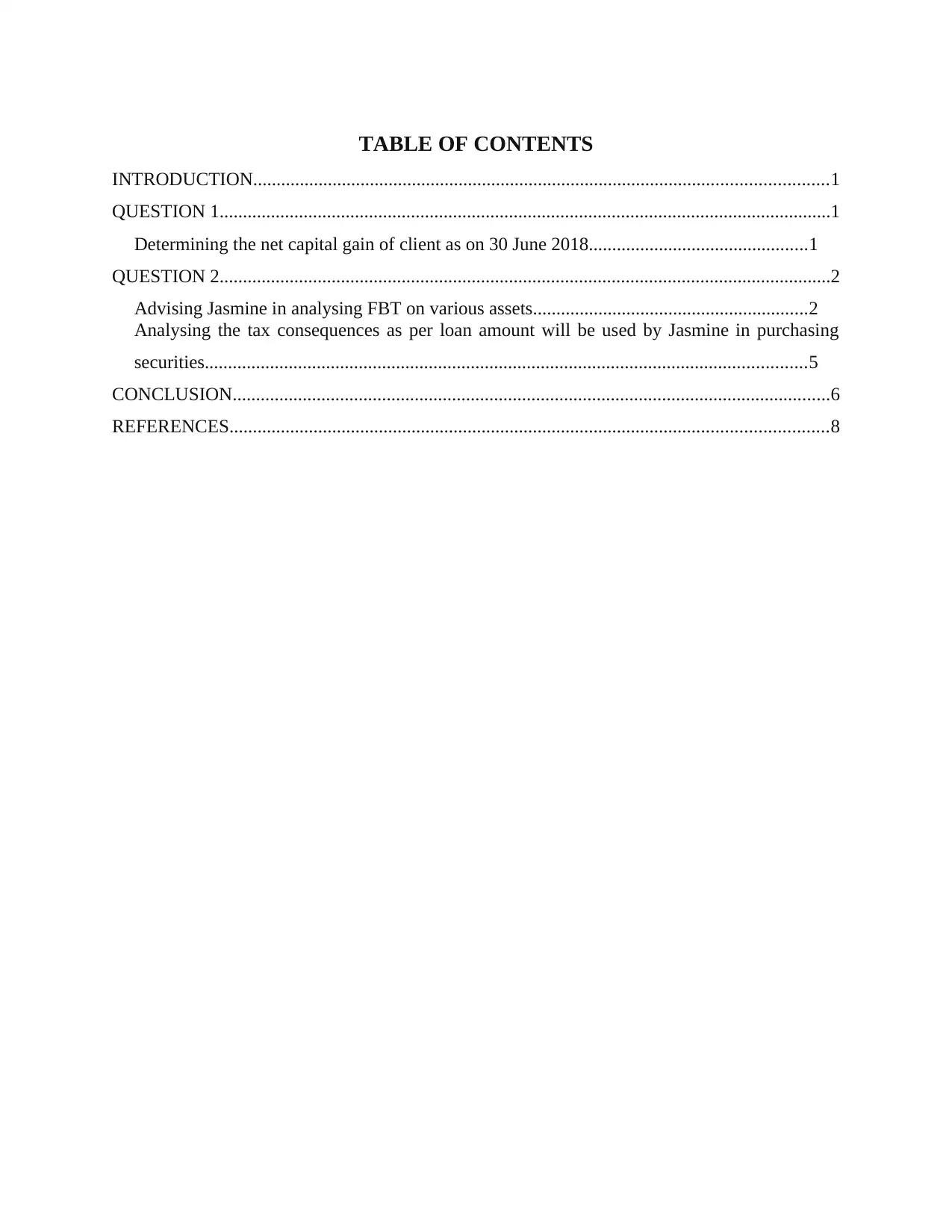
TABLE OF CONTENTS
INTRODUCTION...........................................................................................................................1
QUESTION 1...................................................................................................................................1
Determining the net capital gain of client as on 30 June 2018...............................................1
QUESTION 2...................................................................................................................................2
Advising Jasmine in analysing FBT on various assets...........................................................2
Analysing the tax consequences as per loan amount will be used by Jasmine in purchasing
securities.................................................................................................................................5
CONCLUSION................................................................................................................................6
REFERENCES................................................................................................................................8
INTRODUCTION...........................................................................................................................1
QUESTION 1...................................................................................................................................1
Determining the net capital gain of client as on 30 June 2018...............................................1
QUESTION 2...................................................................................................................................2
Advising Jasmine in analysing FBT on various assets...........................................................2
Analysing the tax consequences as per loan amount will be used by Jasmine in purchasing
securities.................................................................................................................................5
CONCLUSION................................................................................................................................6
REFERENCES................................................................................................................................8
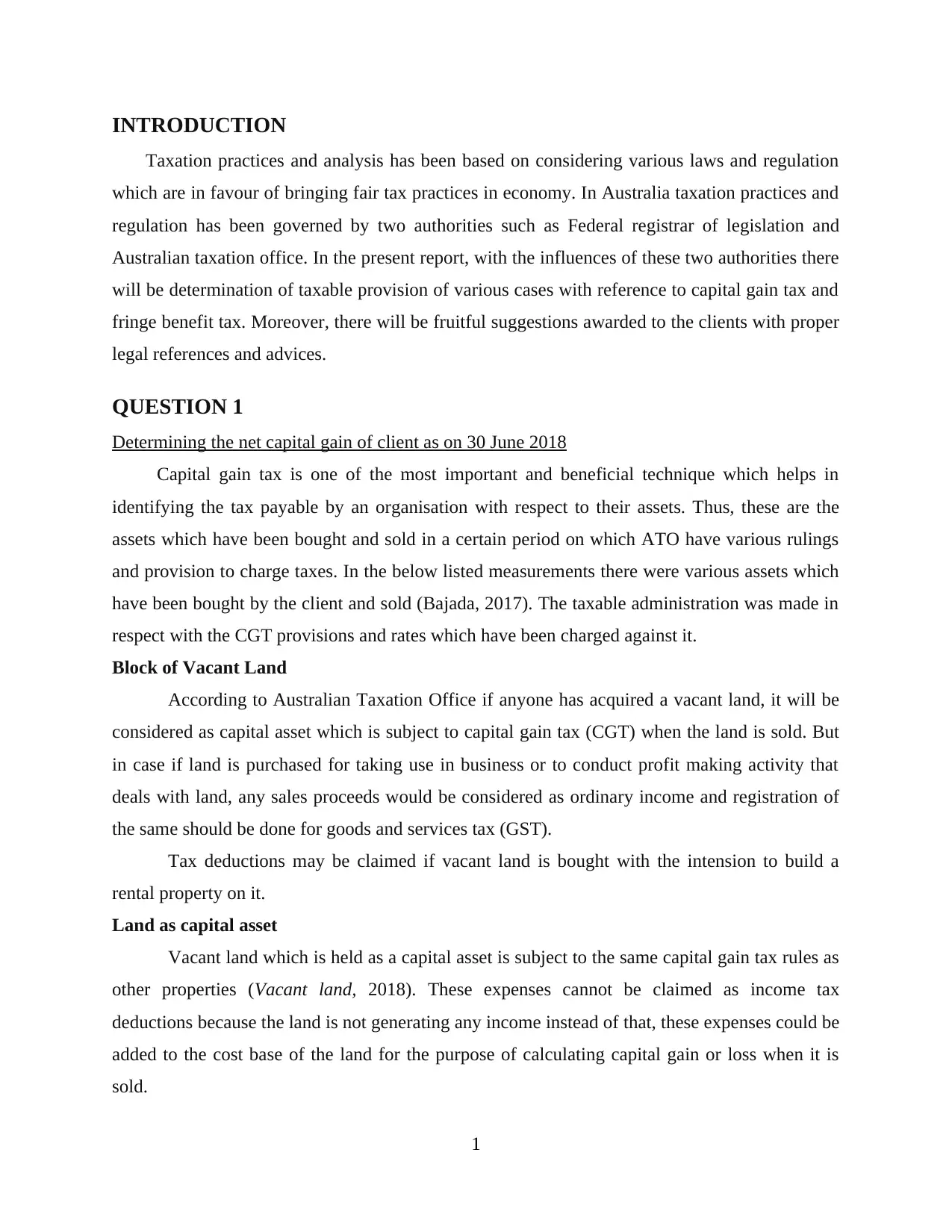
INTRODUCTION
Taxation practices and analysis has been based on considering various laws and regulation
which are in favour of bringing fair tax practices in economy. In Australia taxation practices and
regulation has been governed by two authorities such as Federal registrar of legislation and
Australian taxation office. In the present report, with the influences of these two authorities there
will be determination of taxable provision of various cases with reference to capital gain tax and
fringe benefit tax. Moreover, there will be fruitful suggestions awarded to the clients with proper
legal references and advices.
QUESTION 1
Determining the net capital gain of client as on 30 June 2018
Capital gain tax is one of the most important and beneficial technique which helps in
identifying the tax payable by an organisation with respect to their assets. Thus, these are the
assets which have been bought and sold in a certain period on which ATO have various rulings
and provision to charge taxes. In the below listed measurements there were various assets which
have been bought by the client and sold (Bajada, 2017). The taxable administration was made in
respect with the CGT provisions and rates which have been charged against it.
Block of Vacant Land
According to Australian Taxation Office if anyone has acquired a vacant land, it will be
considered as capital asset which is subject to capital gain tax (CGT) when the land is sold. But
in case if land is purchased for taking use in business or to conduct profit making activity that
deals with land, any sales proceeds would be considered as ordinary income and registration of
the same should be done for goods and services tax (GST).
Tax deductions may be claimed if vacant land is bought with the intension to build a
rental property on it.
Land as capital asset
Vacant land which is held as a capital asset is subject to the same capital gain tax rules as
other properties (Vacant land, 2018). These expenses cannot be claimed as income tax
deductions because the land is not generating any income instead of that, these expenses could be
added to the cost base of the land for the purpose of calculating capital gain or loss when it is
sold.
1
Taxation practices and analysis has been based on considering various laws and regulation
which are in favour of bringing fair tax practices in economy. In Australia taxation practices and
regulation has been governed by two authorities such as Federal registrar of legislation and
Australian taxation office. In the present report, with the influences of these two authorities there
will be determination of taxable provision of various cases with reference to capital gain tax and
fringe benefit tax. Moreover, there will be fruitful suggestions awarded to the clients with proper
legal references and advices.
QUESTION 1
Determining the net capital gain of client as on 30 June 2018
Capital gain tax is one of the most important and beneficial technique which helps in
identifying the tax payable by an organisation with respect to their assets. Thus, these are the
assets which have been bought and sold in a certain period on which ATO have various rulings
and provision to charge taxes. In the below listed measurements there were various assets which
have been bought by the client and sold (Bajada, 2017). The taxable administration was made in
respect with the CGT provisions and rates which have been charged against it.
Block of Vacant Land
According to Australian Taxation Office if anyone has acquired a vacant land, it will be
considered as capital asset which is subject to capital gain tax (CGT) when the land is sold. But
in case if land is purchased for taking use in business or to conduct profit making activity that
deals with land, any sales proceeds would be considered as ordinary income and registration of
the same should be done for goods and services tax (GST).
Tax deductions may be claimed if vacant land is bought with the intension to build a
rental property on it.
Land as capital asset
Vacant land which is held as a capital asset is subject to the same capital gain tax rules as
other properties (Vacant land, 2018). These expenses cannot be claimed as income tax
deductions because the land is not generating any income instead of that, these expenses could be
added to the cost base of the land for the purpose of calculating capital gain or loss when it is
sold.
1
⊘ This is a preview!⊘
Do you want full access?
Subscribe today to unlock all pages.

Trusted by 1+ million students worldwide
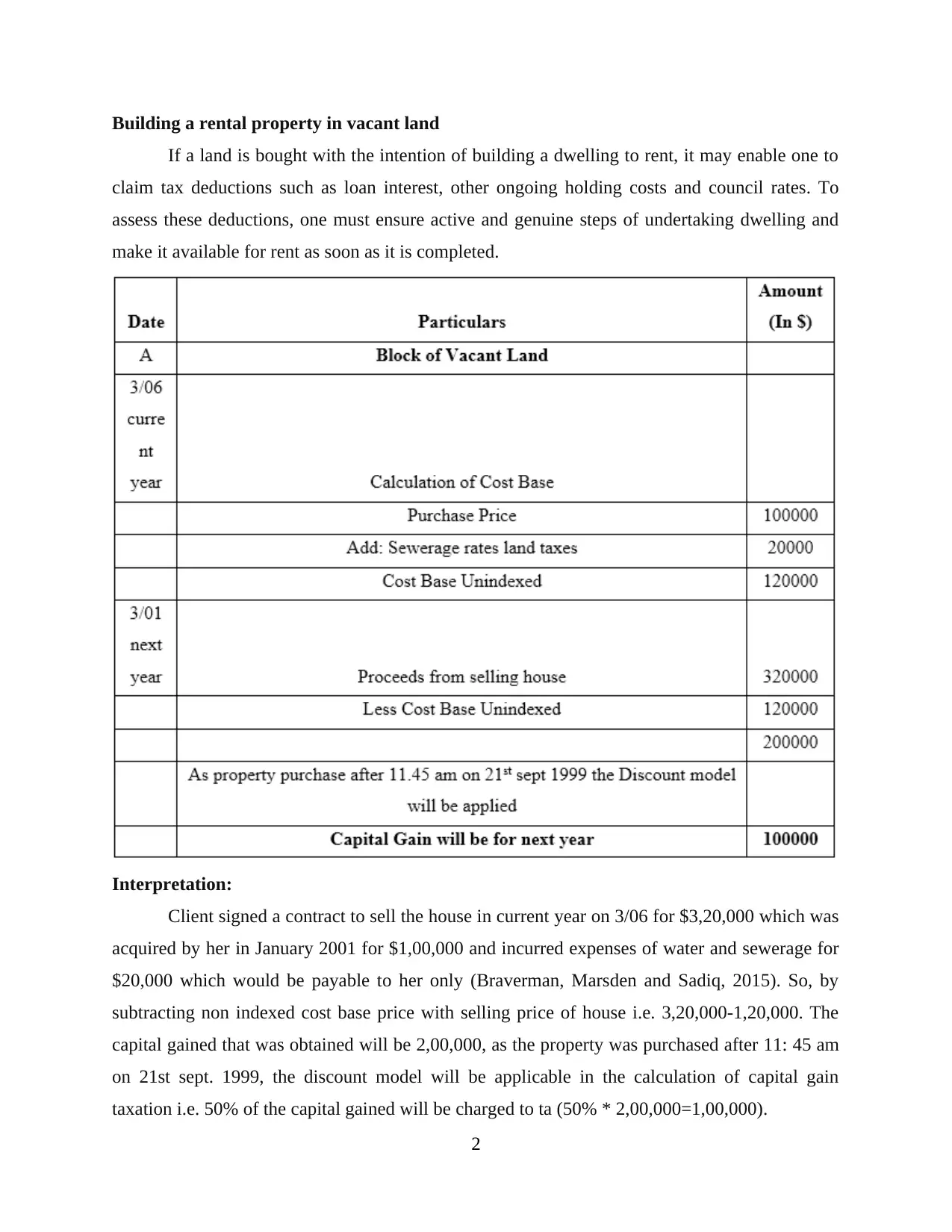
Building a rental property in vacant land
If a land is bought with the intention of building a dwelling to rent, it may enable one to
claim tax deductions such as loan interest, other ongoing holding costs and council rates. To
assess these deductions, one must ensure active and genuine steps of undertaking dwelling and
make it available for rent as soon as it is completed.
Interpretation:
Client signed a contract to sell the house in current year on 3/06 for $3,20,000 which was
acquired by her in January 2001 for $1,00,000 and incurred expenses of water and sewerage for
$20,000 which would be payable to her only (Braverman, Marsden and Sadiq, 2015). So, by
subtracting non indexed cost base price with selling price of house i.e. 3,20,000-1,20,000. The
capital gained that was obtained will be 2,00,000, as the property was purchased after 11: 45 am
on 21st sept. 1999, the discount model will be applicable in the calculation of capital gain
taxation i.e. 50% of the capital gained will be charged to ta (50% * 2,00,000=1,00,000).
2
If a land is bought with the intention of building a dwelling to rent, it may enable one to
claim tax deductions such as loan interest, other ongoing holding costs and council rates. To
assess these deductions, one must ensure active and genuine steps of undertaking dwelling and
make it available for rent as soon as it is completed.
Interpretation:
Client signed a contract to sell the house in current year on 3/06 for $3,20,000 which was
acquired by her in January 2001 for $1,00,000 and incurred expenses of water and sewerage for
$20,000 which would be payable to her only (Braverman, Marsden and Sadiq, 2015). So, by
subtracting non indexed cost base price with selling price of house i.e. 3,20,000-1,20,000. The
capital gained that was obtained will be 2,00,000, as the property was purchased after 11: 45 am
on 21st sept. 1999, the discount model will be applicable in the calculation of capital gain
taxation i.e. 50% of the capital gained will be charged to ta (50% * 2,00,000=1,00,000).
2
Paraphrase This Document
Need a fresh take? Get an instant paraphrase of this document with our AI Paraphraser
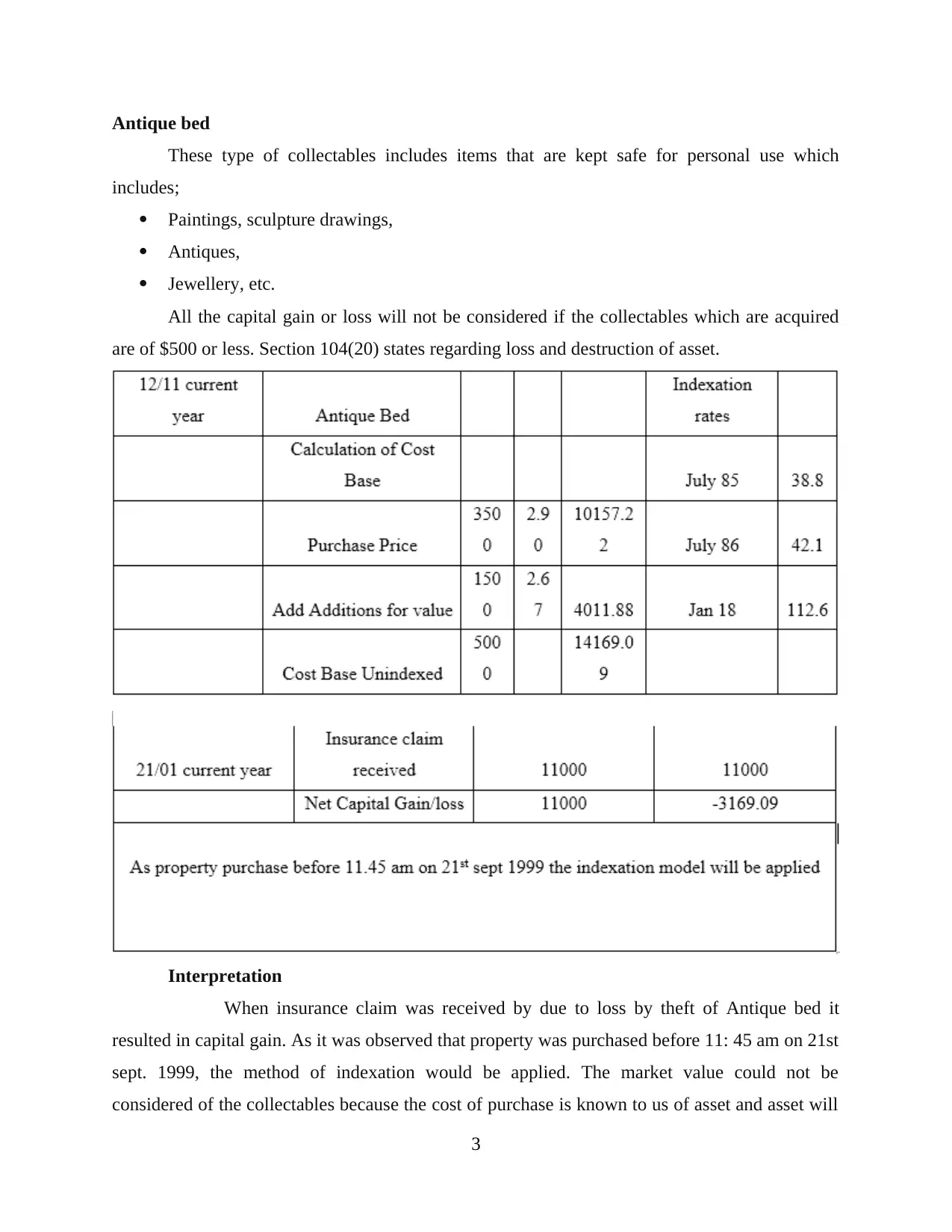
Antique bed
These type of collectables includes items that are kept safe for personal use which
includes;
Paintings, sculpture drawings,
Antiques,
Jewellery, etc.
All the capital gain or loss will not be considered if the collectables which are acquired
are of $500 or less. Section 104(20) states regarding loss and destruction of asset.
Interpretation
When insurance claim was received by due to loss by theft of Antique bed it
resulted in capital gain. As it was observed that property was purchased before 11: 45 am on 21st
sept. 1999, the method of indexation would be applied. The market value could not be
considered of the collectables because the cost of purchase is known to us of asset and asset will
3
These type of collectables includes items that are kept safe for personal use which
includes;
Paintings, sculpture drawings,
Antiques,
Jewellery, etc.
All the capital gain or loss will not be considered if the collectables which are acquired
are of $500 or less. Section 104(20) states regarding loss and destruction of asset.
Interpretation
When insurance claim was received by due to loss by theft of Antique bed it
resulted in capital gain. As it was observed that property was purchased before 11: 45 am on 21st
sept. 1999, the method of indexation would be applied. The market value could not be
considered of the collectables because the cost of purchase is known to us of asset and asset will
3
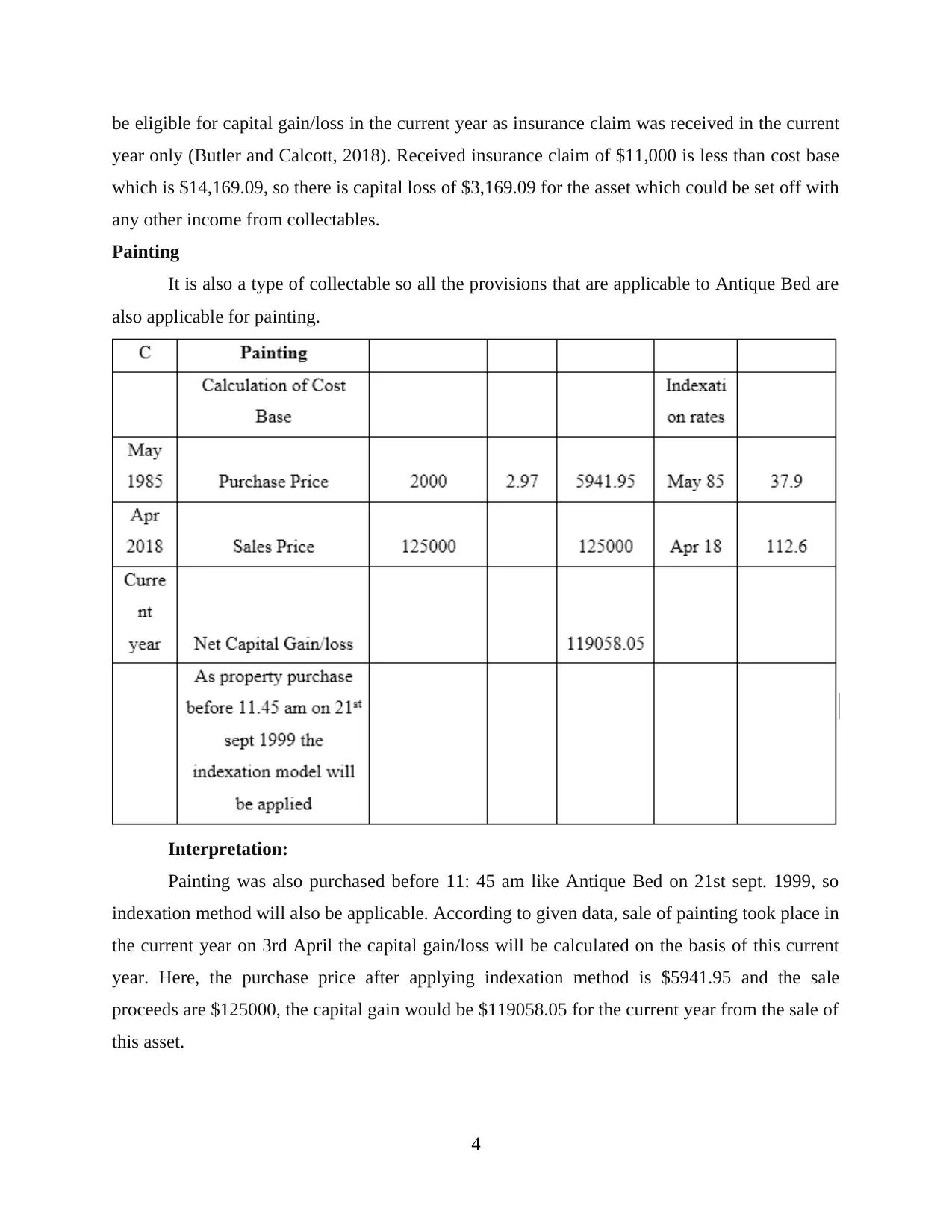
be eligible for capital gain/loss in the current year as insurance claim was received in the current
year only (Butler and Calcott, 2018). Received insurance claim of $11,000 is less than cost base
which is $14,169.09, so there is capital loss of $3,169.09 for the asset which could be set off with
any other income from collectables.
Painting
It is also a type of collectable so all the provisions that are applicable to Antique Bed are
also applicable for painting.
Interpretation:
Painting was also purchased before 11: 45 am like Antique Bed on 21st sept. 1999, so
indexation method will also be applicable. According to given data, sale of painting took place in
the current year on 3rd April the capital gain/loss will be calculated on the basis of this current
year. Here, the purchase price after applying indexation method is $5941.95 and the sale
proceeds are $125000, the capital gain would be $119058.05 for the current year from the sale of
this asset.
4
year only (Butler and Calcott, 2018). Received insurance claim of $11,000 is less than cost base
which is $14,169.09, so there is capital loss of $3,169.09 for the asset which could be set off with
any other income from collectables.
Painting
It is also a type of collectable so all the provisions that are applicable to Antique Bed are
also applicable for painting.
Interpretation:
Painting was also purchased before 11: 45 am like Antique Bed on 21st sept. 1999, so
indexation method will also be applicable. According to given data, sale of painting took place in
the current year on 3rd April the capital gain/loss will be calculated on the basis of this current
year. Here, the purchase price after applying indexation method is $5941.95 and the sale
proceeds are $125000, the capital gain would be $119058.05 for the current year from the sale of
this asset.
4
⊘ This is a preview!⊘
Do you want full access?
Subscribe today to unlock all pages.

Trusted by 1+ million students worldwide
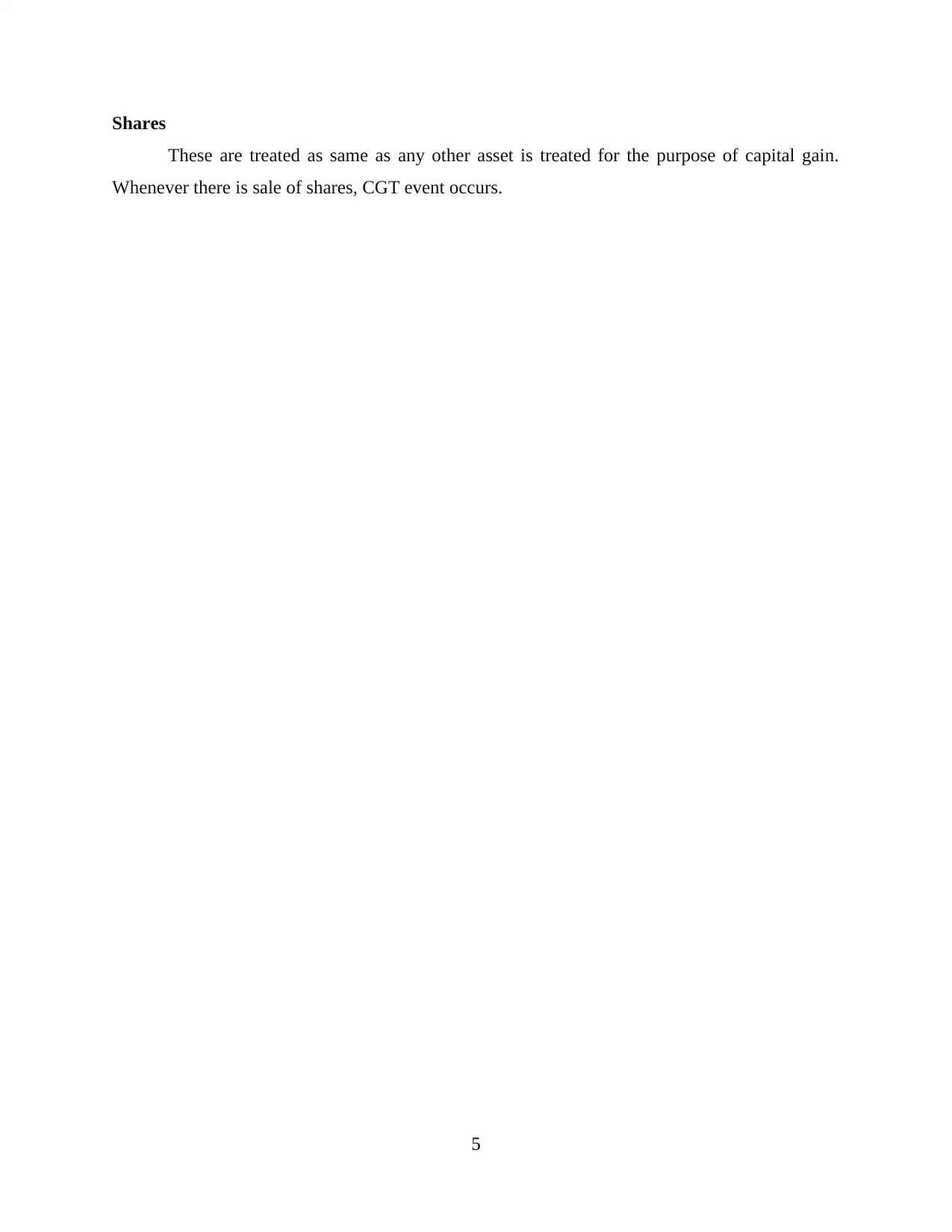
Shares
These are treated as same as any other asset is treated for the purpose of capital gain.
Whenever there is sale of shares, CGT event occurs.
5
These are treated as same as any other asset is treated for the purpose of capital gain.
Whenever there is sale of shares, CGT event occurs.
5
Paraphrase This Document
Need a fresh take? Get an instant paraphrase of this document with our AI Paraphraser
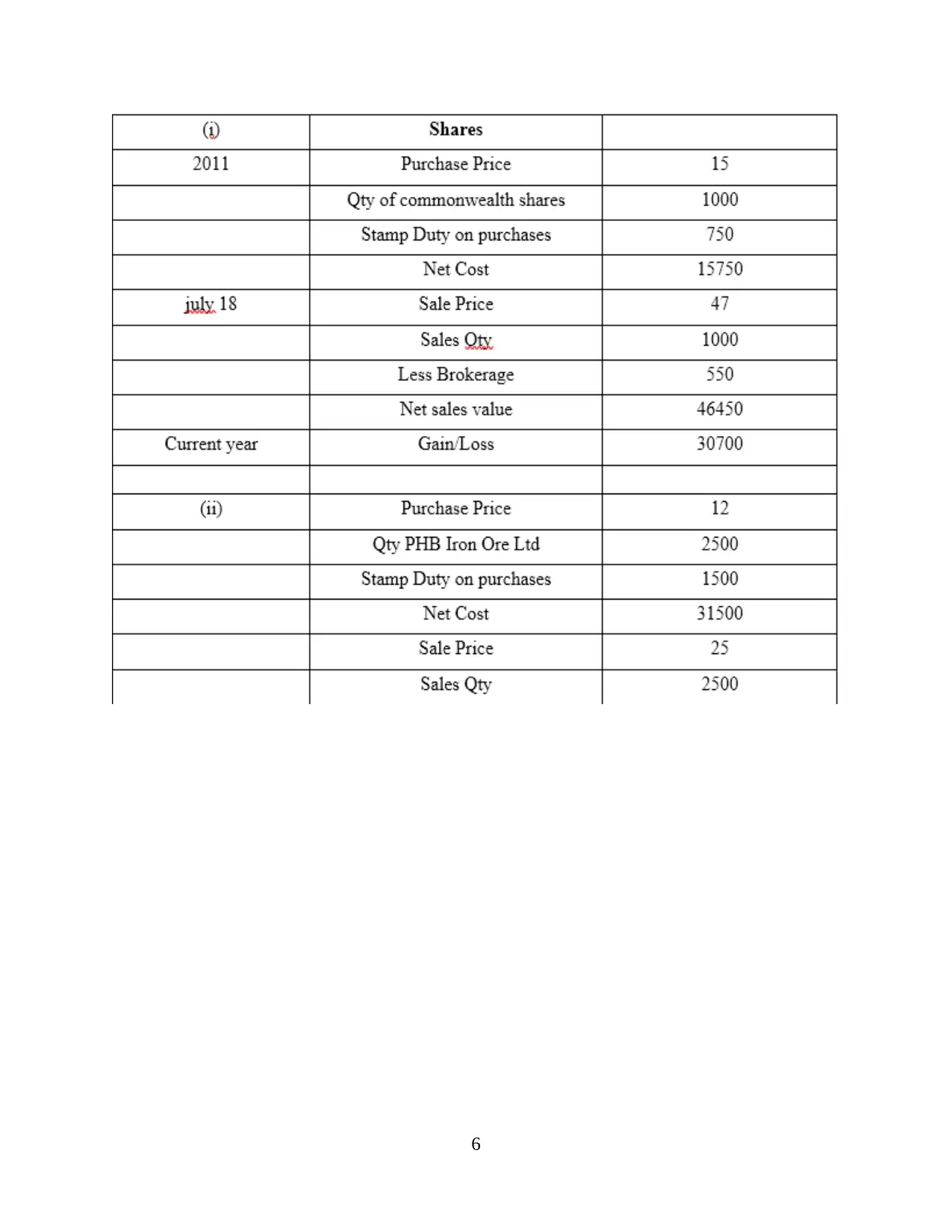
6
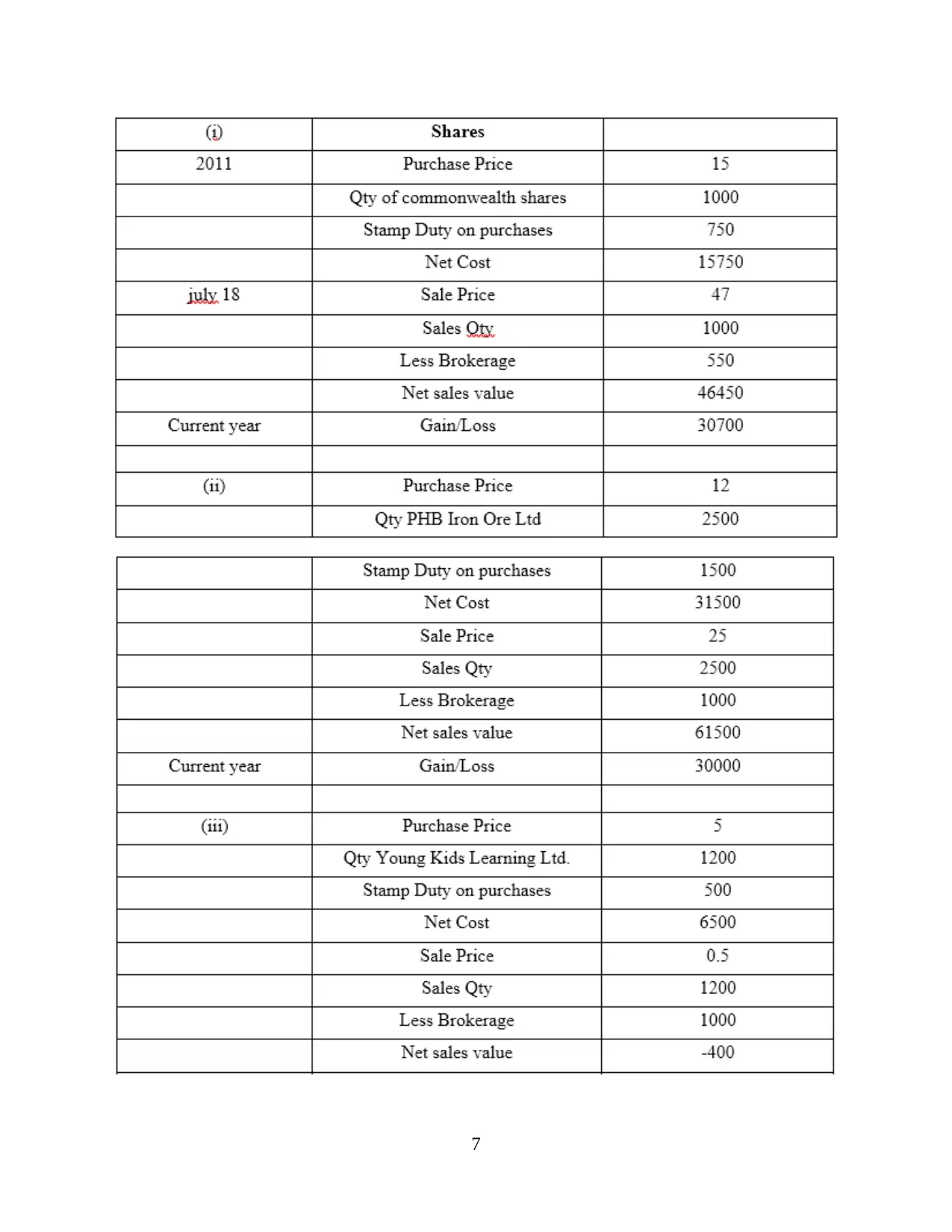
7
⊘ This is a preview!⊘
Do you want full access?
Subscribe today to unlock all pages.

Trusted by 1+ million students worldwide
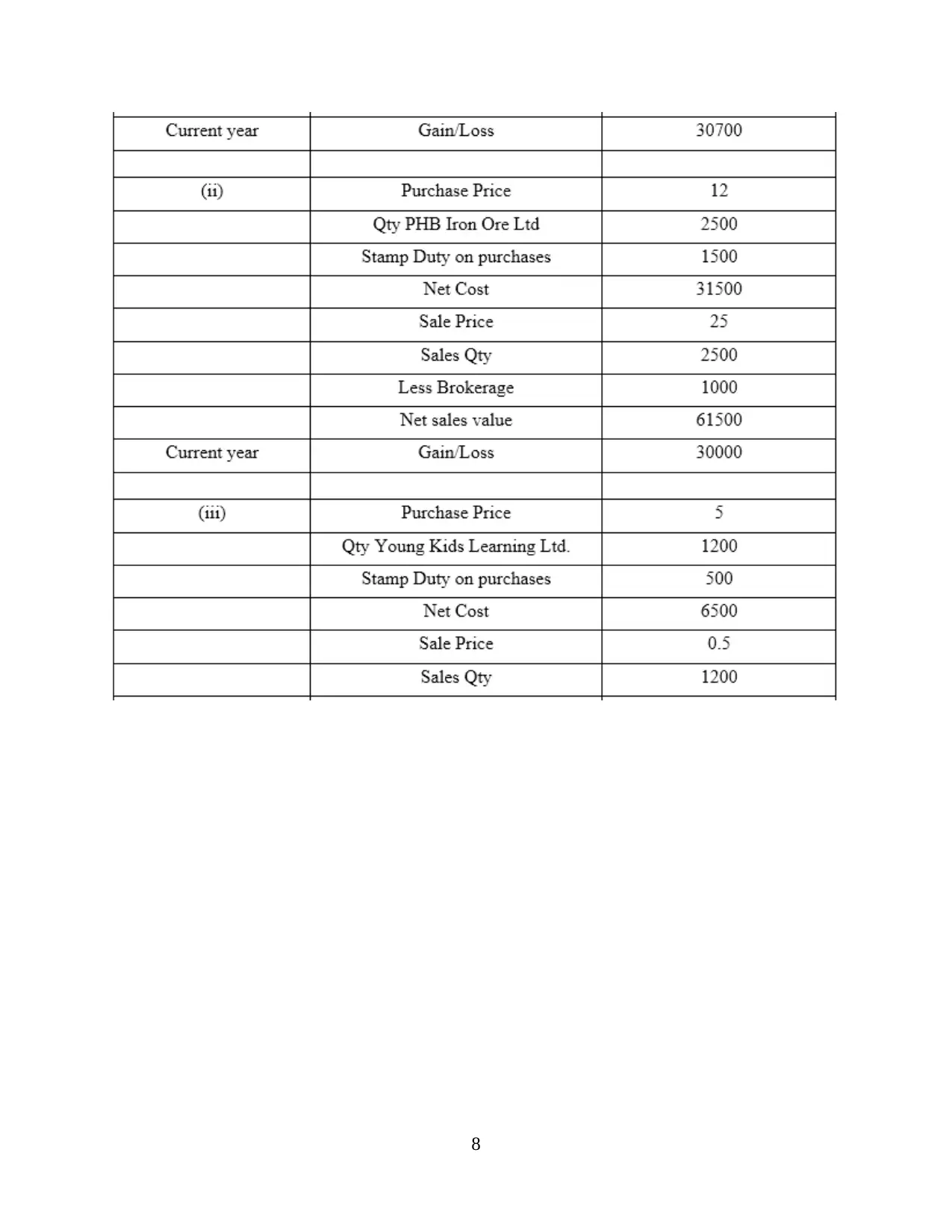
8
Paraphrase This Document
Need a fresh take? Get an instant paraphrase of this document with our AI Paraphraser
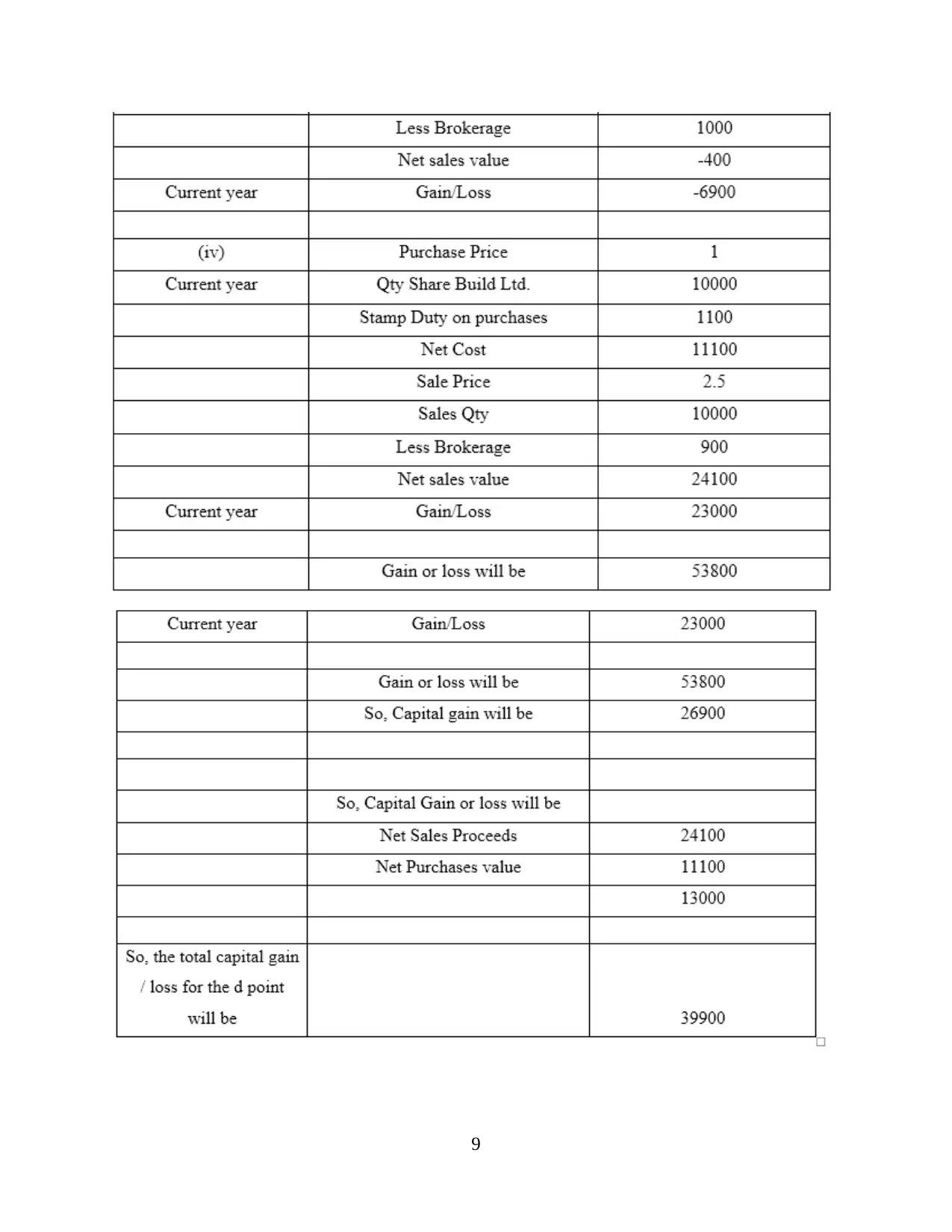
9
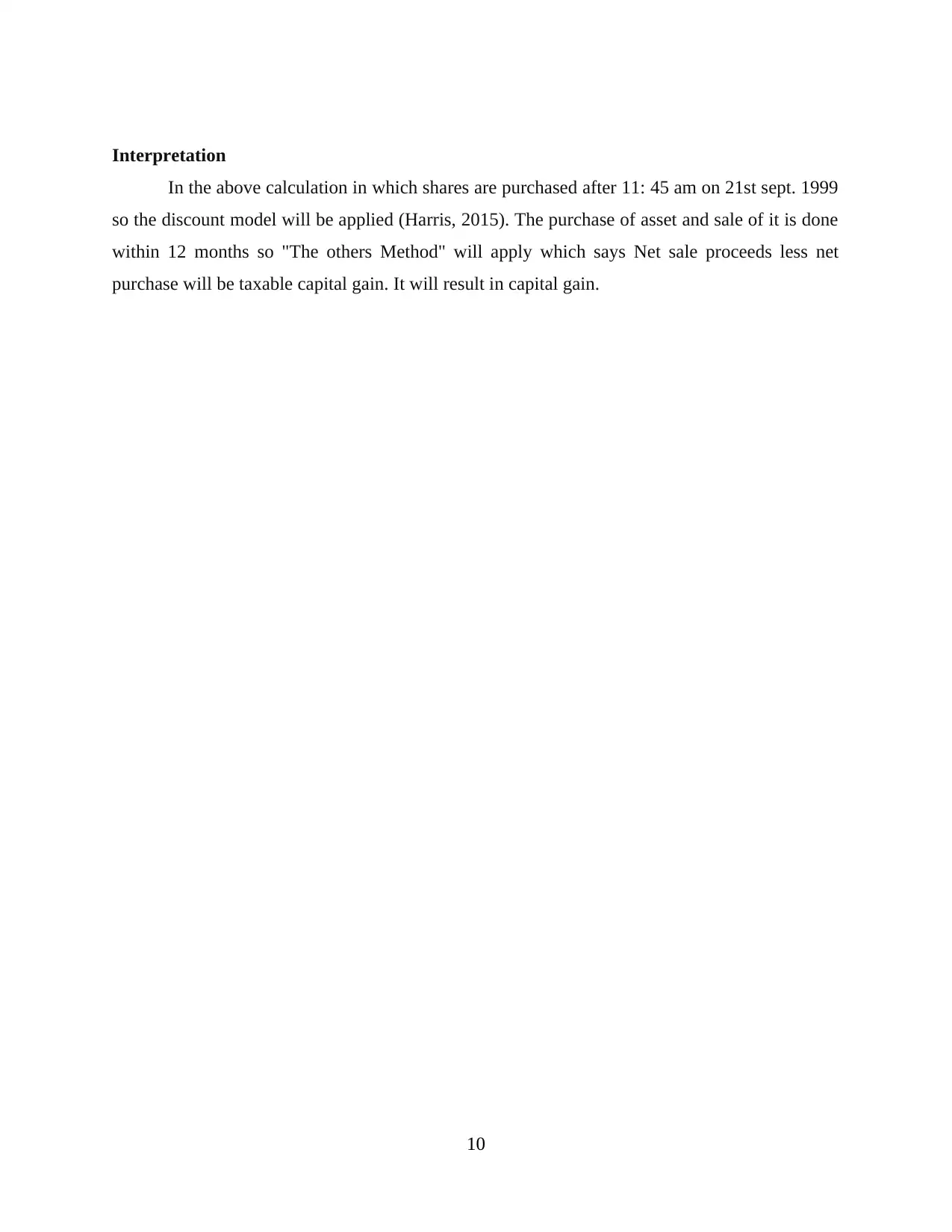
Interpretation
In the above calculation in which shares are purchased after 11: 45 am on 21st sept. 1999
so the discount model will be applied (Harris, 2015). The purchase of asset and sale of it is done
within 12 months so "The others Method" will apply which says Net sale proceeds less net
purchase will be taxable capital gain. It will result in capital gain.
10
In the above calculation in which shares are purchased after 11: 45 am on 21st sept. 1999
so the discount model will be applied (Harris, 2015). The purchase of asset and sale of it is done
within 12 months so "The others Method" will apply which says Net sale proceeds less net
purchase will be taxable capital gain. It will result in capital gain.
10
⊘ This is a preview!⊘
Do you want full access?
Subscribe today to unlock all pages.

Trusted by 1+ million students worldwide
1 out of 20
Related Documents
Your All-in-One AI-Powered Toolkit for Academic Success.
+13062052269
info@desklib.com
Available 24*7 on WhatsApp / Email
![[object Object]](/_next/static/media/star-bottom.7253800d.svg)
Unlock your academic potential
Copyright © 2020–2026 A2Z Services. All Rights Reserved. Developed and managed by ZUCOL.





